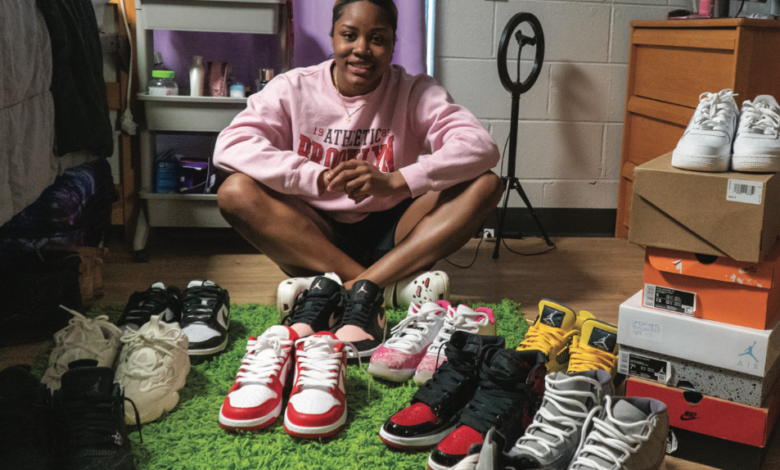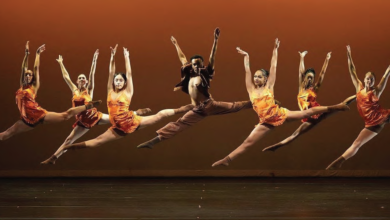
The rise and fall of sneaker collecting: sneakerhead students struggle while shopping for shoes
By Jeremy Hester
The shimmering red and black high-top Patent Bred Air Jordan 1s are currently senior sports media major Lenaejha Evans’ favorite pair of sneakers. She owns 16 different pairs overall, with her collection consisting of Jordan 1s, 4s and 11s.
Junior graphic design major Jessika Schiffer’s collection consists of Jordan 1s, Yeezys and several white Air Forces, “because I customize them,” she said. Many of her hand-painted shoes are featured on her Instagram account @j.s.customs_ with designs that include dragons, flowers, butterflies, Spider-Man and Kobe Bryant.
Evans and Schiffer are both sneakerheads: a subculture of people who collect and trade sneakers as a hobby.
“I like sneakers because I’m able to style them in different ways,” Evans said. “I like the different colorways, designs, fabrics on the shoe and the details.”
Schiffer said, “They can transform an outfit completely … It’s also one of the first things I notice about someone’s outfit.”
Origin of sneakerheads
The emergence of sneaker culture can be attributed to two major factors: Michael Jordan and hip-hop music.
In 1984, Jordan teamed up with Nike to release the first line of Air Jordan Brand sneakers. As an NBA rookie, Jordan wore a pair of red and black Nike Air Ships — a prototype of what would later become the Air Jordan 1 — to his sixth preseason game with the Chicago Bulls.
“I felt like I wanted to be different,” Jordan recalled in a 2016 promotional video. “The league said, ‘Well, we’ve gotta stop that.’”
David Stern, the NBA commissioner at the time, outlawed the sneakers for not having enough white on them. But Nike capitalized on this story by creating an ad campaign surrounding the rebellious nature of basketball superstar Jordan’s banned sneakers.
Around the same time, rap culture began to popularize sneakers, turning them into a status symbol. Rapper LL Cool J wore a pair of Jordan 1s on the back cover of his 1985 debut album “Radio,” and in May 1986, hip-hop group Run-DMC released the song “My Adidas.” Record scratches and a sparse, thumping beat are featured along with lyrics like “My Adidas and me, close as can be/We make a mean team, my Adidas and me.” This song ultimately led to a sponsorship deal with the brand. The relationship between hip-hop and sneakers has persisted to this day, with rapper Kanye West’s exclusive line of Yeezy sneakers being one of the most prominent modern examples.
Taking Ls
Purchasing sneakers has always been challenging. Sneaker companies like Nike and Adidas have a history of using artificial scarcity to build hype, meaning there are never actually enough shoes to go around. It wasn’t uncommon for early sneakerheads to camp out in front of stores all night for a new pair. Riots, muggings and even murders have also been associated with sneaker culture since the first Air Jordans dropped. However, the digital age has created a completely new set of obstacles.
Although Nike’s SNKRS app was originally designed to make it easier for sneakerheads to get their hands
on new shoes through its raffle-like system, the app has become synonymous with disappointment.
“I don’t know how I feel about [SNKRS] because I’ve never won,” Schiffer said with a dry laugh.
Evans expressed a similar sentiment, saying, “I’m upset because I do it every time and every time I don’t win, not once.”
The app has been known to glitch during sneaker drops, with users experiencing anything from infinitely long loading screens to having to re-enter payment information multiple times. One Apple app store review called the app “the worst thing to happen to the sneaker community,” while another said, “unless you have a bot to complete a transaction in less than a millisecond, don’t even waste your time.”
Evans and Schiffer also complained about bots — computer programs designed to buy sneakers in mass quantities, typically to resell at a higher price — while talking about their experiences with SNKRS. Schiffer pointed to bots as one of the biggest problems with the app, while Evans said that bots are unfair to those who genuinely want to buy the latest sneaker drop.
“You have people who don’t even want the shoe, but they end up winning. It’s like bro, you don’t want that shoe,” Evans said. “I think it’s unfair, they have bots and stuff, and they allow these bots to get, like, 50 plus wins … it’s unfair to those who actually want it, because they’re allowing these bots and resellers to just get the shoe and resell it for more.”
One recent example of egregious bot usage can be found in the story of Oregon reseller Joe Hebert. Last year, many sneakerheads would’ve felt lucky to cop a single pair of the patchwork gray and white Yeezy Boost 350 Zyons. A then-19-year-old Hebert and his team purchased 600 pairs, despite the limit of one pair per customer, by using bots.
Hebert spent about $132,000 on the shoes and resold them all the same day, flipping them for a $20,000 profit, according to news coverage. In a Bloomberg article about his business, Hebert said, “if you know the right people, this is the city to sell shoes,” referring to his hometown of Portland, Oregon, where Nike and Adidas base their U.S. operations.
However, the same Bloomberg article revealed that “the right people” included his mother, Ann Hebert. The 600 pairs of Yeezys were purchased with an American Express corporate card owned by Hebert’s mother, who had served as the vice president and general manager of Nike North America for several years. Although Nike says there were no conflicts of interest, Ann Hebert resigned five days after the article was published. Joe Hebert is still reselling today, but many sneakerheads view him and resellers like him as a blight on the sneaker game.
Discussing resellers, Evans said, “That’s their side hustle, that’s how they make money. So that’s cool, like, do you. But if you have people out here that really want shoes and they can’t get them because they’re like $400, $500, that just defeats everybody’s purpose.”
Inside a cook group
In sneakerhead slang, to “cook” means to buy. Cook groups are online sneaker-buying communities that
use messaging apps like Discord or Slack to plan and coordinate their attacks, with most groups charging monthly membership fees.
Universal Cook is a Discord cook group that charges members $15 a month for “monitors” that scan the internet and alert users the moment a new shoe gets released, access to auto-checkout bots, guides on how to resell sneakers and even potential backdoor sneaker sources that would allow members to buy sneakers at the retail price before they are available to the public.
Universal Cook members often brag online about their success with bots to each other. One member shared a picture of a huge tower of shoeboxes they’d obtained using bots, including 13 pairs of Black White Nike Dunks, three pairs of Vintage Green Nike Dunks, six pairs of Yeezy slides and a pair of yellow Retro Lightning Jordan 4s. Another member complained about how they “only got 10” pairs of black and purple Social Status Jordan 6s. One member was so confident that they’d be able to use bots to buy a pair of cream- colored Retro Air Jordan 3s that they sold them to StockX, a marketplace website, “before I even bought.”
Groups like Universal Cook exemplify how sneaker culture has changed in recent years. What used to be a method of self-expression has turned into a high-value resale market focused solely on profit.
The future of sneakerheads?
Shoe companies are starting to realize that many sneakerheads are exasperated by the current state of sneaker culture. According to PowerPoint slides and other details from an internal meeting at Nike in October 2021 that was leaked to Complex, it was revealed that Nike only satisfied 7% of desired sales on the SNKRS app in that year, down from 13% in 2020 and 2019, and that disenfranchised customers are turning to “smaller, independent brands.”
Although SNKRS Vice President Ron Faris said during the meeting that Nike does a great job of defending against bots despite what the public thinks, he also said that the company needs to do better for those who have been “gentrified out and alienated by the resale market,” specifically the “Black and brown communities and Asian communities” that were essential in creating the sneakerhead subculture before it went mainstream.
The meeting ended with plans to build a more fair experience around sneaker launches and a promise
to start listening more to the sneaker community as a whole. Discouraged collectors can only hope that Nike keeps their word and other brands follow suit.
Despite these frustrations, many sneakerheads still love the thrill of the chase.
“Sometimes the work to get them is fun,” Evans said. “You look back at the adventure you went on … and you just have to laugh because you did all that for a shoe.”



